RESEARCH
New methods for estimating the tuberculosis case detection rate in high-HIV prevalence countries: the example of Kenya
Nouvelles méthodes d'estimation du taux de dépistage de la tuberculose dans les pays à forte prévalence du VIH: exemple du Kenya
Nuevos métodos para estimar la tasa de detección de casos de tuberculosis en los países con alta prevalencia de VIH: el ejemplo de Kenya
John MansoerI; Suzanne ScheeleII; Katherine FloydII; Christopher DyeII; Joseph SitieneiIII; Brian WilliamsII, *
IUS Department of Health and Human Services, Centers for Disease Control and Prevention, Nairobi, Kenya
IIStop TB Department, World Health Organization, 20 avenue Appia, 1211 Geneva 27, Switzerland
IIINational Leprosy and Tuberculosis Control Programme, Nairobi, Kenya
ABSTRACT
OBJECTIVE: To develop new methods for estimating the sputum smear-positive tuberculosis case detection rate (CDR) in a country where infection with HIV is prevalent.
METHODS: We estimated the smear-positive tuberculosis CDR in HIV-negative and HIV-positive adults, and in all adults in Kenya. Data on time trends in tuberculosis case notification rates and on HIV infection prevalence in adults and in tuberculosis patients were used, along with data on tuberculosis control programme performance.
FINDINGS: In 2006, the estimated smear-positive tuberculosis CDR in HIV-negative adults was 79% (95% confidence interval, CI: 64-94) and in HIV-positive adults, 57% (95% CI: 26-88), giving a weighted mean of 68% (95% CI: 49-87). The separate estimate for all smear-positive tuberculosis cases was 72% (95% CI: 53-91), giving an overall average for the three estimates of 70% (95% CI: 58-82). As the tuberculosis CDR in 1996 was 57% (95% CI: 47-67), the estimated increase by 2006 was 13 percentage points (95% CI: 6-20), or 23%. This increase was accompanied by a more than doubling of the resources devoted to tuberculosis control in Kenya, including facilities and staff.
CONCLUSION: Using three approaches to estimate the tuberculosis CDR in a country where HIV infection is prevalent, we showed that expansion of the tuberculosis control programme in Kenya led to an increase of 23% in the CDR between 1996 and 2006. While the methods developed here can be applied in other countries with a high prevalence of HIV infection, they rely on precise data on trends in such prevalence in the general population and among tuberculosis patients.
RÉSUMÉ
OBJECTIF: Mettre au point de nouvelles méthodes pour estimer le taux de dépistage de la tuberculose à frottis positifs dans les pays de forte prévalence des infections à VIH.
MÉTHODES: Nous avons estimé ce taux chez les adultes positifs et négatifs pour le VIH et chez l'ensemble des adultes au Kenya. Nous avons utilisé des données de tendance dans le temps des taux de notification de la tuberculose et des données de prévalence de l'infection à VIH chez les adultes et les individus tuberculeux, ainsi que des informations sur les performances du programme de lutte antituberculeuse.
RÉSULTATS: En 2006, le taux de dépistage des cas de tuberculose à frottis positifs chez les adultes négatifs pour le VIH était estimé à 79 % (intervalle de confiance à 95 %, IC : 64-94) et chez les adultes positifs pour ce virus à 57 % (IC à 95 % : 26-88), ce qui donnait une moyenne pondérée de 68 % (IC à 95 % : 49-87). En estimant séparément le taux de dépistage pour l'ensemble des cas de tuberculose à frottis positifs, on obtenait une valeur de 72 % (IC à 95 % : 53-91), d'où une moyenne globale pour les trois estimations de 70 % (IC à 95 % : 58-82). Le taux de dépistage de la tuberculose en 1996 étant de 57 % (IC à 95 % : 47-67), l'augmentation entre 1996 et 2006 a été estimée à 13 points de pourcentage (IC à 95 % : 6-20), soit 23 %. En parallèle à cet accroissement, le montant des ressources consacrées à la lutte antituberculeuse au Kenya, y compris les installations et le personnel, a plus que doublé.
CONCLUSION: En utilisant trois approches pour estimer le taux de dépistage de la tuberculose dans un pays de forte prévalence du VIH, nous avons montré que l'expansion du programme de lutte antituberculeuse kenyan avait entraîné une augmentation de 23 % du taux de dépistage de la tuberculose entre 1996 et 2006. Bien que les méthodes mises au point puissent être appliquées dans d'autres pays de forte prévalence des infections à VIH, cette application doit s'appuyer sur des données précises concernant les tendances de la prévalence de ces infections parmi la population générale et les individus tuberculeux.
RESUMEN
OBJETIVO: Desarrollar nuevos métodos para estimar la tasa de detección de casos (TDC) de tuberculosis con frotis de esputo positivo en un país con alta prevalencia de infección por VIH.
MÉTODOS: Estimamos la TDC de tuberculosis bacilífera en adultos VIH-negativos y VIH-positivos, así como en todos los adultos de Kenya. Se utilizaron datos sobre las tendencias temporales de las tasas de notificación de casos de tuberculosis y sobre la prevalencia de la infección por VIH en los adultos y en los pacientes con tuberculosis, junto con datos sobre la eficacia del programa de lucha antituberculosa.
RESULTADOS: En 2006, la TDC estimada de tuberculosis bacilífera fue del 79% (intervalo de confianza, IC, del 95%: 64-94) para los adultos VIH-negativos, y del 57% para los VIH-positivos, (IC95%: 26-88), lo que arroja una media ponderada del 68% (IC95%: 49-87). La estimación correspondiente a todos los casos bacilíferos de tuberculosis fue del 72% (IC95%: 53-91), lo que arroja una media global para las tres estimaciones del 70% (IC95%: 58-82). Dado que la TDC de tuberculosis en 1996 fue del 57% (IC95%: 47-67), el aumento estimado para 2006 es de 13 puntos porcentuales (IC95%: 6-20), lo que supone un incremento del 23%. Este aumento se asoció a una más que duplicación de los recursos dedicados al control de la tuberculosis en Kenya, incluidos trabajadores e instalaciones.
CONCLUSION: Estimando de tres formas distintas la TDC en un país con alta prevalencia de infección por VIH, mostramos que la expansión del programa de lucha antituberculosa en Kenya condujo a un aumento del 23% de la TDC entre 1996 y 2006. Aunque pueden aplicarse en otros países con alta prevalencia de VIH, los métodos aquí desarrollados exigen datos precisos sobre las tendencias de esa prevalencia en la población general y entre los enfermos de tuberculosis.
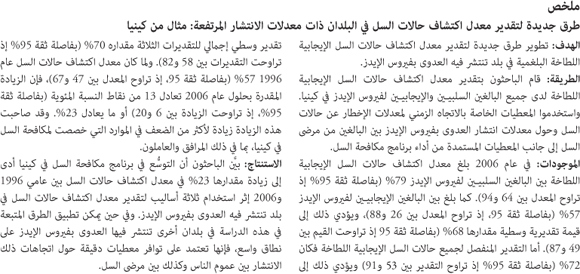
Introduction
The tuberculosis (TB) case detection rate (CDR) is the ratio of the number of notified TB cases to the number of incident TB cases in a given year. One key target for TB control programmes worldwide is achieving a sputum smear-positive CDR greater than 70%.1 In Kenya, previous estimates indicate a drop in the TB CDR from 57% in 1996 to 43% in 2005.2 However, the 2005 estimate is questionable for several reasons. First, the 1996 estimate was based on the combination of limited available data and expert opinion.3 Second, this estimate was then projected forward in time by assuming that the incidence of TB had changed in proportion to the notification rate for all forms of TB,2 an assumption that becomes increasingly questionable and unreliable over time. The observed notification rate divided by the projected incident cases was then used to derive the 2005 CDR. Better methods of estimating the CDR are needed. The problem lies with the denominator of the ratio because it is difficult to measure the incidence of TB disease directly. Most countries rely on indirect methods such as: (i) applying the Stýblo ratio to data derived from surveys of the prevalence of infection, (ii) using registry data to estimate the proportion of TB deaths that are also recorded in TB registers, or (iii) measuring disease prevalence and dividing it by an estimate of disease duration.2,4 However, none of these methods provides a precise incidence estimate.
In all of southern and most of eastern Africa, including Kenya, the epidemic of infection with HIV has led to a more than 10-fold increase in the incidence of TB since the epidemic started in the early 1980s, making it difficult to determine how much of any rise in TB case notifications is due to improved case detection rather than the impact of HIV. However, we can use the known impact of HIV infection on the incidence of TB to our advantage provided we have good data on TB and HIV infection and on their interaction. The objective of this paper is to report on three new methods for estimating the CDR for smear-positive TB using data on HIV infection in both adults in general and TB patients. We focus on Kenya, where significant progress has been made in TB control over the last 10 years and almost all TB patients are now tested for HIV.
Between 1990 and 2006, the notification rate for all forms of TB in Kenya increased from 50 to 300 per 100 000 population3 (Fig. 1), a rise that reflects both the impact of the HIV epidemic2 as well as improvements in the CDR. The challenge lies in separating changes in TB notification rate due to an increased CDR from those generated by the impact of HIV infection.
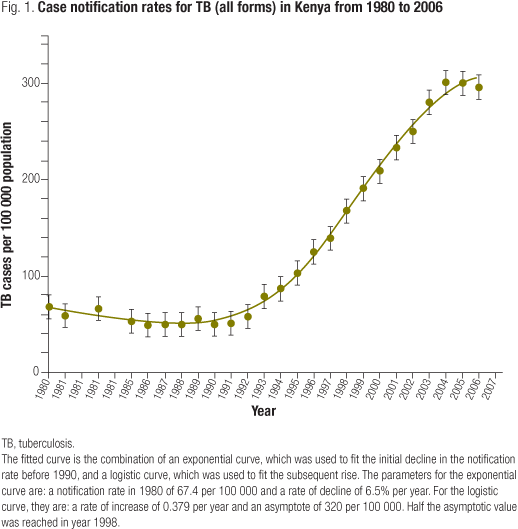
Methods
We used three methods to estimate the CDR. First, we used the time trend in the notification rate of smear-positive TB among HIV-negative adults to estimate the increase in the CDR for smear-positive TB among these HIV-negative adults. Second, we used the probability that an HIV-positive individual would develop smear-positive TB to estimate the CDR for smear-positive TB in HIV-positive adults. Third, we used an estimate of the year after which the HIV epidemic would no longer drive up the incidence of TB to calculate the increase in the CDR for smear-positive TB in all adults. The data and assumptions used in these three methods are described below.
Trend data
The trend in the prevalence of HIV infection in Kenyan adults5 between 1990 and 2004 is shown in Fig. 2. As can be seen, it peaked in 1997. To determine the time trend in TB notifications according to HIV status, we used a limited but very important 1994 survey of HIV infection in TB patients7 and more extensive measurements of HIV infection in TB patients made in 2006. We used the 1994 and 2006 data to interpolate the prevalence of HIV infection in TB patients in 1996. To do so, we first adjusted the 19947 survey data to correct for sampling biases. In that survey, the prevalence of HIV was reported for an unspecified mix of smear-positive, smear-negative and extrapulmonary TB patients in each district for all case types combined. However, for all districts combined, the prevalence was reported for each case type. Smear-positive patients were deliberately oversampled. We therefore proceeded as follows (full details available from the corresponding author on request): We started with the prevalence of HIV infection in TB patients for all case types in each district and, from the survey data,7 calculated the odds ratio (OR) for HIV infection in smear-positive TB patients compared with all TB patients, which was found to be 0.82 (95% confidence interval, CI: 0.68-0.98). We used this OR to estimate the prevalence of HIV in smear-positive TB patients in each district. We then interpolated the estimates for 1994 and 2006 to estimate the prevalence of HIV in TB patients in each district in 1996, under the assumption that it increased logistically at the same rate as the TB notification rate shown in Fig. 1. We then calculated the average value, with its confidence limits, of the log of the OR for HIV infection among TB patients for 1996 and 2006, which we applied to national data. This gave an estimated OR of 0.44 (95% CI: 0.30-58) and a prevalence estimate of 0.30 (95% CI: 0.23-0.37) for HIV infection among TB patients.
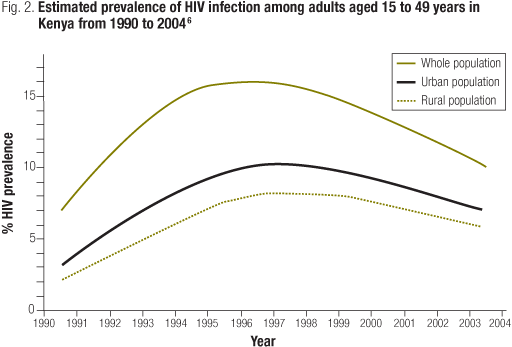
Data on time trends in the TB notification rate, the prevalence of HIV in TB patients in 2006, and the numbers of health facilities, diagnostic facilities, suspected TB patients examined and staff involved in the TB control programme were obtained from the national programme.
Assumptions
We made three sets of assumptions concerning, respectively: (i) TB transmission from HIV-positive to HIV-negative individuals, (ii) the annual risk that an HIV-positive individual would develop TB disease, and (iii) the time course of the impact of HIV on the incidence of TB disease.
First, there is evidence that people with TB are less infectious to others and are more likely to die or seek treatment if they are also infected with HIV.8-10 We let the risk of TB in an HIV-positive individual be α times the risk in an HIV-negative individual, the infectiousness of an HIV-positive individual be β times that of an HIV-negative individual, the duration of TB disease in an HIV-positive individual be ρ times the duration in an HIV-negative individual, and the prevalence of HIV in the adult population be p. Then, in the presence of HIV infection, transmission of TB will increase by a factor R, where

From Equation 1, it can be seen that transmission will remain constant as the prevalence of HIV increases provided αβρ = 1 and that HIV infection may increase or decrease the transmission of TB depending on whether or not the combination αβρ is greater than or less than 1. It has been found that β is close to but slightly less than 1.11 Also, a systematic review gave a value of α = 10 (95% CI: 5-22),12 and a study carried out among smear-positive gold miners in South Africa8 gave a value of ρ = 0.15 (95% CI: 0.00-0.73). Using these values, R = 1.5 (95% CI: 0.3-8.7). Although R is close to 1, the data are not sufficiently precise to determine whether HIV infection will increase or decrease the incidence of TB disease. However, there is direct evidence that in some settings the HIV epidemic did not increase the risk of TB infection in HIV-negative individuals. In a seminal study of gold miners lasting 9 years,9 the incidence of TB in HIV-negative men remained constant, while the incidence of TB in HIV-positive men increased by five times,9 suggesting that R must be close to 1. Here, our first assumption is that the HIV epidemic increased the incidence of TB disease but not TB transmission.
The second assumption concerns the lifetime risk that an HIV-positive individual will develop TB. If, as above, we let the prevalence of HIV in adults be p and the annual risk that an HIV-positive individual will develop TB be π, then the incidence of TB in HIV-positive individuals will be pπ. Now, if the proportion of HIV-positive TB patients who are smear-positive is σ, then the incidence of smear-positive TB in HIV-positive individuals will be pπσ. Finally, if the smear-positive case notification rate among those with HIV is n per year, then the smear-positive CDR among HIV-positive individuals will be

The parameter with the greatest uncertainty is π, the annual risk that an HIV-positive individual will develop TB. In published papers, π has been reported to be between 5% and 15% per annum,13-17 but no paper has provided strong supporting evidence for its estimate of π. Furthermore, the value of π is likely to increase as an HIV epidemic matures and the proportion of HIV-positive individuals whose immune system is severely compromised increases. In the study of gold miners in South Africa referred to above,9 the incidence of TB in HIV-positive men increased from 2% to 10% per annum between 1991 and 2000 as the HIV epidemic matured. One systematic review assessed the risk of TB disease by allowing for a nonlinear relationship between the risk of disease and the time from seroconversion.12,18-26 Averaged over the lifetime of HIV-positive individuals, the incidence of TB was estimated to be 5.0% (95% CI: 2.5-10) per annum,12 which is the value we used for the annual incidence of TB among HIV-positive individuals never treated with antiretrovirals.
The third assumption is that the incidence of TB peaked in 2001, 4 years after the estimated peak in HIV infection prevalence. The mean value of the reported median CD4 cell counts at which HIV-positive individuals develop TB is 200 cells/μl,12,27 with some variation among studies. This occurs, on average, about 8 years after seroconversion so that, at the population level, there is likely to be a delay of about 8 years between the rise in the incidence of HIV and the rise in the incidence of TB. Since the prevalence of HIV infection peaks about 4 years after the incidence of HIV,28 the delay between the peak prevalence of HIV infection and the peak incidence in TB is likely to be about 4 years.29 The prevalence of HIV infection in Kenya peaked in 1997 (Fig. 2), so we would expect any increase in the incidence of TB disease due to HIV to have peaked by 2000. Here we assume, conservatively, that the impact of HIV on TB remained constant after the year 2000. We therefore fitted a logistic curve to the data up to 2000, which reflected the increase in HIV-related TB, and used this curve to predict the expected notification rate, in the absence of changes in the CDR, beyond the year 2000 (Fig. 3).
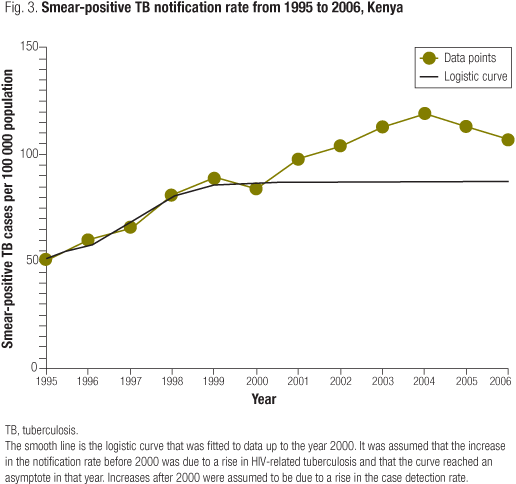
An estimate of the 1997 smear-positive TB CDR in Kenya was made by a panel of experts, including regional advisers and WHO staff in the WHO African Region, and was extrapolated to 1996.2 The smear-positive TB incidence in preceding and subsequent years was then calculated on the assumption that the smear-positive TB incidence was proportional to a 3-year moving average of the notification rate for all forms of TB. On this basis, the smear-positive TB CDR for 1996 was found to be 57%,2 and, to allow for uncertainties in making the original estimate, we assumed an error in this estimate of ±10%.
Results
HIV-negative individuals
In 1996, the smear-positive TB notification rate in Kenya was 61 per 100 000 population2 and in 2006, it was 124 per 100 000, according to TB control programme data. In 1996, the estimated prevalence of HIV in smear-positive TB patients was 30% (95% CI: 23-37) and, in 2006, the measured prevalence was 52% (95% CI: 51.5-52.5). The annual smear-positive TB notification rate in HIV-negative individuals therefore increased from 42.5 per 100 000 in 1996 to 59.5 per 100 000 in 2006, or 40% (95% CI: 30-50). Taking the 1997 smear-positive TB CDR of 57% (95% CI: 47-67), as derived above, the estimated smear-positive TB CDR in HIV-negative individuals for 2006 would be 79% (95% CI: 64-94).
HIV-positive individuals
In Kenya in 2006, 52% of TB patients were HIV-positive, giving a smear-positive TB notification rate in HIV-positive individuals, n, of 60 per 100 000, and the prevalence of HIV in adults in the general population, p, was 0.07 (95% CI: 0.06-0.08) (Fig. 2). We assumed that the proportion of HIV-positive TB cases that were smear-positive, σ, was 0.30 (95% CI: 0.25-0.35).30 Assuming that the annual risk that an HIV-positive individual will develop TB, π, is 0.05 (95% CI: 0.025-0.10), as derived above, Equation 2 gives 57% (95% CI: 26-88) as the smear-positive TB CDR in HIV-positive individuals.
All adults
In the final method, we attribute the increase in TB notifications before 2000 to the effect of HIV, and the increase after 2000 to improved performance of the TB control programme. Between 2000 and 2006, the case notification rate increased by 26% (95% CI: 16-36), from 85 to 107 per 100 000 population. Assuming that the TB CDR remained constant between 1996 and 2000, as indicated by programme performance data shown in Fig. 4, Fig. 5 and Fig. 6 (available at: http://www.who.int/bulletin/volumes/87/03/08-051474/en/index.html ), and using the 1996 smear-positive TB CDR of 57% (95% CI: 47-67), as derived above, as the value for the year 2000, we obtain a 2006 smear-positive TB CDR for all adults of 72% (95% CI: 53-91).
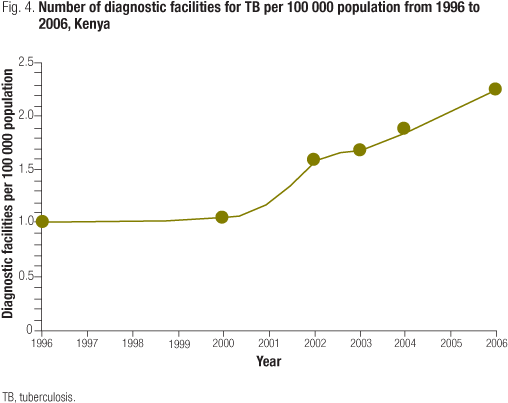
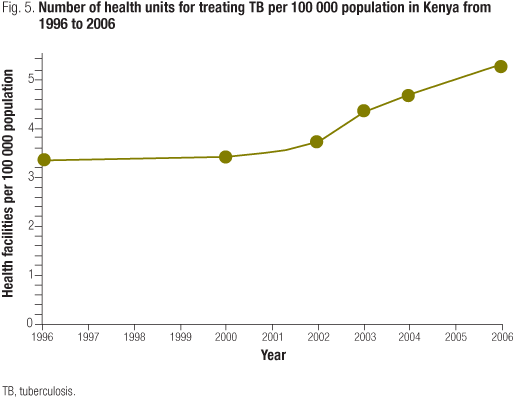
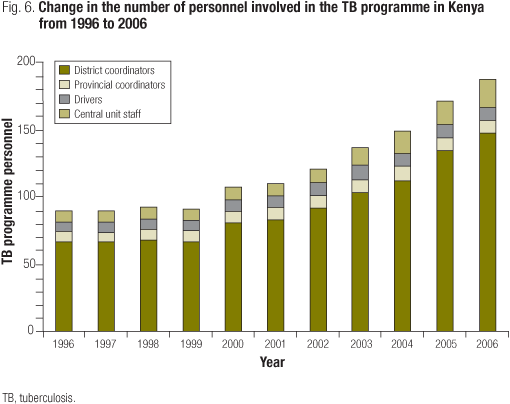
Discussion
Over the last 6 years, there has been a significant increase in the TB diagnostic effort in Kenya. Between 2000 and 2006, the number of TB diagnostic facilities increased by 122% (Fig. 4), the number of health facilities providing TB treatment increased by 58% (Fig. 5) and the number of suspected TB patients examined increased by 470% (Fig. 7), while the staff involved more than doubled, with 83% of the increase occurring at the district level (Fig. 6). It would have been surprising if this increase in diagnostic effort, facilities and staff had not led to an increase in the TB CDR.
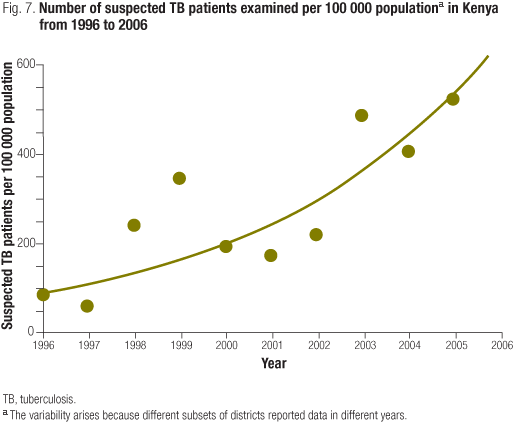
Here we estimated the TB CDR in three different ways. The first estimate of 79% (95% CI: 64-94) for the smear-positive TB CDR in HIV-negative individuals may be an overestimate because it assumes that the HIV epidemic had no impact on the incidence of TB among those who were HIV-negative. Furthermore, while we now have precise data for the prevalence of HIV in TB patients, this was not the case in 1996 and the confidence limits are correspondingly wide. The second estimate of 57% (95% CI: 26-88) for the smear-positive TB CDR in HIV-positive individuals is lower, but not significantly lower, than the estimate for HIV-negative individuals. In this case, the main source of uncertainty lay in the annual risk that an HIV-positive individual would develop TB. The weighted average of these first two estimates gives an overall estimate for the TB CDR in all patients of 68% (95% CI: 49-87). The third estimate of 72% (95% CI: 53-91) for the smear-positive TB CDR in all adults lies between the other two. This estimate assumes that all increases in the CDR took place after the year 2000, at a time when the incidence of TB may have been falling. This could have led to an underestimate of the overall increase in the CDR. The weighted average of the three estimates of the TB CDR is 70% (95% CI: 58-82). While there is considerable uncertainty surrounding the CDR estimate for 1996, with two of the methods used here we first estimated the increase in the CDR between 1996 and 2006. The estimated increase in the CDR in HIV-negative smear-positive TB patients was 40% (95% CI: 30-50), while the estimated increase in HIV-positive smear-positive TB patients was 26% (95% CI: 16-36), giving an average increase of 33% (95% CI: 26-40). Regardless of the actual TB CDR in 2006, there certainly appears to have been a significant increase between 1996 and 2006.
In seven of the 22 countries with a high burden of TB, the prevalence of HIV infection is greater than 10%, while in another four countries it is between 5% and 10%. Of these countries, only Kenya has reported TB notifications classified by HIV status, although surveys of the prevalence of HIV infection have been carried out in four more.31 Fortunately, the importance of routinely reporting the prevalence of HIV infection in TB patients is increasingly being recognized, and much better data should become available over the next few years. By monitoring the notification rate in HIV-negative TB patients it will be possible to better monitor trends in the CDR in many more countries.
It is important to acknowledge that the uncertainty in all these estimates arises not only from our imprecise knowledge of the prevalence of HIV infection in all adults and, historically, in TB patients, but also from our still relatively poor understanding of the dynamics of the relationship between HIV infection and TB disease. As noted above, the smear-positive TB CDR in Kenya in 1996 was estimated by a panel of experts, including regional advisers and WHO staff in the WHO African Region,2 so it is uncertain as well.
Conclusion
The Millennium Development Goals32 (MDGs) highlight the need for improved measurement of health indicators, including TB-specific MDG indicators such as incidence, prevalence, mortality, success with DOTS (directly observed treatment, short course), and case detection with DOTS. Most TB occurs in countries with weak routine communicable disease surveillance systems, and progress towards case detection targets relies on uncertain estimates of the incidence of TB disease. The substantial impact of HIV on the incidence of TB disease and the effect of rapidly expanding TB control programmes on case notification must be evaluated carefully to reduce the uncertainty surrounding estimates of incidence and, thus, of the CDR.
This analysis suggests that the TB CDR in Kenya increased from 57% (95% CI: 47-67) in 1996 to 70% (95% CI: 58-82) in 2006, an increase of 23% or 13 percentage points (95% CI: 6-20). Thus, Kenya has probably reached, or is very close to reaching, the 70% target set for 2005. If the quality of the TB programme can be maintained and the prevalence of HIV infection among adults continues to drop, TB transmission in Kenya is likely to decline in the years ahead, and this should be reflected in the notification rates for cases of HIV-negative smear-positive TB. National surveillance of HIV in adults and TB patients has been weak in all countries, but the situation has begun to change in some. Fortunately, testing for HIV is rapidly becoming routine practice in Kenya. In 2006, 564 000 women attending antenatal clinics (representing approximately 40% of live births) were tested for HIV and, by the end of 2006, approximately 60% of all TB patients had been tested for HIV. If these high rates of testing can be maintained or even increased, it will be possible to directly measure trends in HIV infection in the general population and in TB patients. Applying the methods developed here to more accurate data will make it possible to obtain significantly improved estimates of TB control programme performance in settings where the prevalence of HIV infection is high. 
Acknowledgements
We thank the Gates Foundation for its financial support.
Competing interests: None declared.
REFERENCES
1. Stop TB Partnership. The global plan to stop TB, 2006-2015. Geneva: World Health Organization; 2006.
2. Global tuberculosis control: surveillance, planning, financing. Geneva: World Health Organization; 2007.
3. Dye C, Scheele S, Dolin P, Pathania V, Raviglione MC. Global burden of tuberculosis. Estimated incidence, prevalence, and mortality by country. JAMA 1999;282:677-86. PMID:10517722 doi:10.1001/jama.282.7.677
4. Dye C, Bassili A, Bierrenbach AL, Broekmans JF, Chadha VK, Glaziou P, et al. Measuring tuberculosis burden, trends, and the impact of control programmes. Lancet Infect Dis 2008;8:233-43. PMID:18201929 doi:10.1016/S1473-3099(07)70291-8
5. National Aids Control Council. Country Report - Kenya. UNGASS 2006: United Nations General Assembly Special Session on HIV/AIDS. Nairobi: NACC; 2006.
6. Kenya, Ministry of Health. AIDS in Kenya: trends, interventions and impact. 7th edn. Nairobi: National AIDS and STI Control Programme; 2005. Available from: http://www.policyproject.com/pubs/countryreports/KEN_AIDS_7thEd.pdf [accessed on 6 January 2009] .
7. van Gorkom J, Kibuga D, Abdallah S, Adungosi J, Aluvaala B, Kanganai J, et al. HIV-seroprevalence among tuberculosis patients in Kenya. East Afr Med J 1999;76:452-6. PMID:10520351
8. Corbett EL, Charalambous S, Moloi VM, Fielding K, Grant AD, Dye C, et al. Human immunodeficiency virus and the prevalence of undiagnosed tuberculosis in African gold miners. Am J Respir Crit Care Med 2004;170:673-9. PMID:15191919 doi:10.1164/rccm.200405-590OC
9. Corbett EL, Charalambous S, Fielding K, Clayton T, Hayes RJ, De Cock KM, et al. Stable incidence rates of tuberculosis (TB) among human immunodeficiency virus (HIV)-negative South African gold miners during a decade of epidemic HIV-associated TB. J Infect Dis 2003;188:1156-63. PMID:14551886 doi:10.1086/378519
10. Williams B, Maher D. Tuberculosis fuelled by HIV: putting out the flames. Am J Respir Crit Care Med 2007;175:6-8. PMID:17179495 doi:10.1164/rccm.200609-1376ED
11 .Espinal MA, Peréz EN, Baéz J, Henriquez L, Fernandez K, Lopez M, et al. Infectiousness of Mycobacterium tuberculosis in HIV-1-infected patients with tuberculosis: a prospective study. Lancet 2000;355:275-80. PMID:10675075 doi:10.1016/S0140-6736(99)04402-5
12. Williams BG, Dye C. Antiretroviral drugs for tuberculosis control in the era of HIV/AIDS. Science 2003;301:1535-7. PMID:12920302 doi:10.1126/science.1086845
13. Manosuthi W, Chottanapand S, Thongyen S, Chaovavanich A, Sungkanuparph S. Survival rate and risk factors of mortality among HIV/tuberculosis-coinfected patients with and without antiretroviral therapy. J Acquir Immune Defic Syndr 2006;43:42-6. PMID:16885778 doi:10.1097/01.qai.0000230521.86964.86
14. Coetzee D, Hildebrand K, Boulle A, Maartens G, Louis F, Labatala V, et al. Outcomes after two years of providing antiretroviral treatment in Khayelitsha, South Africa. AIDS 2004;18:887-95. PMID:15060436 doi:10.1097/00002030-200404090-00006
15. Lee MP, Chan JW, Ng KK, Li PC. Clinical manifestations of tuberculosis in HIV-infected patients. Respirology 2000;5:423-6. PMID:11192558 doi:10.1046/j.1440-1843.2000.00287.x
16. von Reyn CF. The significance of bacteremic tuberculosis among persons with HIV infection in developing countries. AIDS 1999;13:2193-5. PMID:10563704 doi:10.1097/00002030-199911120-00001
17. Lawn SD, Wood R. Incidence of tuberculosis during highly active antiretroviral therapy in high-income and low-income countries. Clin Infect Dis 2005; 41:1783-6. PMID:16288404 doi:10.1086/498308
18. Holmes CB, Wood R, Badri M, Zilber S, Wang B, Maartens G, et al. CD4 decline and incidence of opportunistic infections in Cape Town, South Africa: Implications for prophylaxis and treatment. J Acquir Immune Defic Syndr 2006; 42:464-9. PMID:16810113 doi:10.1097/01.qai.0000225729.79610.b7
19. Sonnenberg P, Glynn JR, Fielding K, Murray J, Godfrey-Faussett P, Shearer S. How soon after infection with HIV does the risk of tuberculosis start to increase? A retrospective cohort study in South African gold miners. J Infect Dis 2005;191:150-8. PMID:15609223 doi:10.1086/426827
20. Moreno S, Baraia-Etxaburu J, Bouza E, Parras F, Pérez-Tascón M, Miralles P, et al. Risk for developing tuberculosis among anergic patients infected with HIV. Ann Intern Med 1993;119:194-8. PMID:8100693
21. Girardi E, Antonucci G, Vanacore P, Libanore M, Errante I, Matteelli A, et al. Impact of combination antiretroviral therapy on the risk of tuberculosis among persons with HIV infection. AIDS 2000;14:1985-91. PMID:10997404 doi:10.1097/00002030-200009080-00015
22. Selwyn PA, Hartel D, Lewis VA, Schoenbaum EE, Vermund SH, Klein RS, et al. A prospective study of the risk of tuberculosis among intravenous drug users with human immunodeficiency virus infection. N Engl J Med 1989; 320:545-50. PMID:2915665
23. Dupon M, Texier-Maugein J, Leroy V, Sentilhes A, Pellegrin JL, Morlat P, et al. Tuberculosis and HIV infection: a cohort study of incidence and susceptibility to antituberculous drugs, Bordeaux, 1985-1993. AIDS 1995;9:577-83. PMID:7662196 doi:10.1097/00002030-199506000-00008
24. Guelar A, Gatell JM, Verdejo J, Podzamczer D, Lozano L, Aznar E, et al. A prospective study of the risk of tuberculosis among HIV-infected patients. AIDS 1993;7:1345-9. PMID:8267907 doi:10.1097/00002030-199310000-00007
25. The Antiretroviral Therapy Cohort Collaboration. Incidence of tuberculosis among HIV-infected patients receiving highly active antiretroviral therapy in Europe and North America. Clin Infect Dis 2005;41:1772-82. PMID:16288403 doi:10.1086/498315
26. Badri M, Wilson D, Wood R. Effect of highly active antiretroviral therapy on incidence of tuberculosis in South Africa: a cohort study. Lancet 2002;359:2059-64. PMID:12086758 doi:10.1016/S0140-6736(02)08904-3
27. Sonnenberg P, Murray J, Glynn JR, Shearer S, Kambashi B, Godfrey-Faussett P. HIV-1 and recurrence, relapse, and reinfection of tuberculosis after cure: a cohort study in South African mineworkers. Lancet 2001;358:1687-93. PMID:11728545 doi:10.1016/S0140-6736(01)06712-5
28. Williams B, Gouws E, Wilkinson D, Abdool Karim S. Estimating HIV incidence rates from age prevalence data in epidemic situations. Stat Med 2001;20:2003-16. PMID:11427956 doi:10.1002/sim.840
29. Nunn P, Williams B, Floyd K, Dye C, Elzinga G, Raviglione M. Tuberculosis control in the era of HIV. Nat Rev Immunol 2005;5:819-26. PMID:16200083 doi:10.1038/nri1704
30. Joint United Nations Programme on HIV/AIDS. 2008 report on the global AIDS epidemic. Geneva: UNAIDS; 2008.
31. Global tuberculosis control: surveillance, planning, financing. Geneva: World Health Organization; 2008. Available from: http://www.unaids.org/en/ [accessed on 6 January 2009] .
32. Resolution A/55/2. United Nations Millennium Declaration. Fifty-fifth United Nations General Assembly, New York, 18 September 2000 (Document A/RES/53/202).
(Submitted: 20 January 2008 - Revised version received: 24 June 2008 - Accepted: 25 June 2008 - Published online: 20 January 2009)
* Correspondence to Brian Williams (e-mail: williamsbg@who.int).
